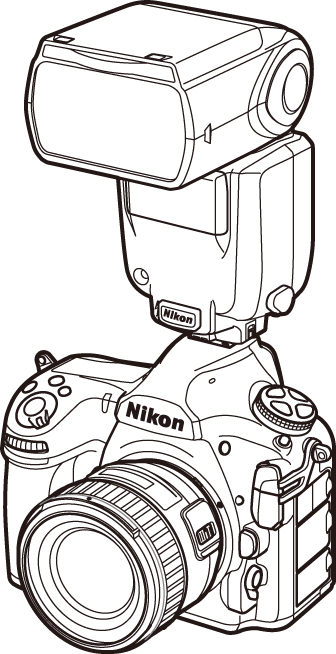Using a Flash
Follow the steps below to mount an optional flash unit on the camera and take photographs using the flash.
See Also
For information on using multiple remote flash units, see “Optional Flash Units” (0 Optional Flash Units).
-
Mount the unit on the accessory shoe.
See the manual provided with the unit for details.

-
Turn on the camera and flash unit.
The flash will begin charging; the flash-ready indicator (c) will be displayed in the viewfinder when charging is complete.
-
Adjust flash settings.
Choose the flash mode (0 Flash Modes) and flash control mode (0 On-Camera Flash Photography).
-
Adjust shutter speed and aperture.
-
Take pictures.
Third-Party Flash Units
The camera cannot be used with flash units that would apply voltages over 250 V to the camera’s X contacts or short-circuit contacts on the accessory shoe. Use of such flash units could not only interfere with normal operation of the camera but also damage the flash sync circuits of the camera and/or flash.
Shutter Speed
Shutter speed can be set as follows when an optional flash unit is used:
| Mode | Shutter speed |
|---|---|
| P, A | Set automatically by camera (1/250 s–1/60 s) * |
| S | Value selected by user (1/250 s–30 s) |
| M | Value selected by user (1/250 s–30 s, Bulb (A), Time (%)) |
Shutter speed may be set as slow as 30 s if slow sync, slow rear-curtain sync, or slow sync with red-eye reduction is selected for flash mode.
The Sync Terminal
A sync cable can be connected to the sync terminal as required. Do not connect another flash unit via a sync cable when performing rear-curtain sync flash photography with a flash unit mounted on the camera accessory shoe.

i-TTL Flash Control
When a CLS-compatible flash unit is set to TTL, the camera automatically selects one of the following types of flash control:
- i-TTL balanced fill-flash for digital SLR: Flash unit emits series of nearly invisible preflashes (monitor preflashes) immediately before main flash. Preflashes reflected from objects in all areas of frame are picked up by RGB sensor with approximately 180K (180,000) pixels and are analyzed in combination with range information from matrix metering system to adjust flash output for natural balance between main subject and ambient background lighting. If type G, E, or D lens is used, distance information is included when calculating flash output. Precision of calculation can be increased for non-CPU lenses by providing lens data (focal length and maximum aperture; 0 Non-CPU Lenses). Not available when spot metering is used.
- Standard i-TTL fill-flash for digital SLR: Flash output adjusted to bring lighting in frame to standard level; brightness of background is not taken into account. Recommended for shots in which main subject is emphasized at expense of background details, or when exposure compensation is used. Standard i-TTL fill-flash for digital SLR is activated automatically when spot metering is selected.
